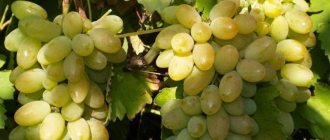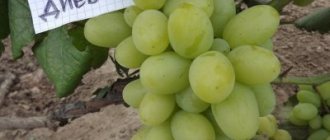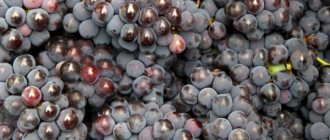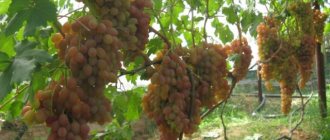Description
The author of the new hybrid is breeder V.V. Zagorulko (Ukraine). Furshetny appeared on the market in 2008, the parent pair are the Kuban and Podarok Zaporozhye varieties.
Belongs to early or mid-early species; with proper care, the berries are ready for picking in 115-130 days. The timing is approximately August 15-18, but the exact time is determined by the climate of the region, weather conditions of the season, and agricultural technology.
It forms quite powerful bushes and is characterized by increased shoot formation. According to the observations of gardeners, for every square meter of planting area there are 14-16 shoots. When planting, take into account the strength of the plants and maintain the distance between the bushes. Vine ripening is 85-90%.
The leaves are large, curly, with strong cuts. The color is bright green. Furshetny does not require replanting of additional varieties for pollination, as it forms bisexual peduncles.
It is grown in different regions; it has proven itself well in the middle zone, the Leningrad region, and the Urals. Thanks to early ripening, as well as good frost resistance, the hybrid manages to produce a harvest even in areas with short summers. But to obtain tasty and juicy berries, more sun and heat are required, otherwise the pulp will taste sour. Productivity indicators are up to 40-50 kg per adult bush.
Official information about the variety
The variety was bred by hybridizing two varieties “Podarok Zaporozhye” and “Kuban”. The author of the hybrid form is the respected folk breeder Zagorulko V.V. Zaporozhye region Ukraine.
The form entered the market in 2008 and has not yet acquired variety status; it has not passed variety testing and has not been entered into the variety register.
However, this did not stop winegrowers from planting their plots and enjoying the taste of grapes.
Description of the vegetative form
The plant is very powerful. Its growth power is enormous and wood growth occurs at a rapid pace.
By planting such grapes near a gazebo or high support, you can easily and quickly close a large space from prying eyes.
The shoot-forming ability of the hybrid form surprised even its creator . Grapes can easily produce 12–14 shoots per meter. The shoots also ripen well.
Bunch
The bunch looks very attractive.
- “Buffet” greatly pleased lovers of large bunches. If today it is no longer surprising, then ten years ago its large bunch and large berries were worthy of admiration.
- The bunch itself is medium in density, very often winged . Its lower part is cylindrical-conical.
Berry
- A berry weight of 12–16 grams is absolutely not the limit . Very often its berries reach 20–22 g. This berry can be up to 4 cm in length and 2.5–3 cm in width.
- The shape of the berry is elongated-oval . The color of this giant is deep blue with a uniform, uniform pruin. Outwardly, such a bunch looks beautiful, dignified and noble.
- The taste of the berry will satisfy those who prefer meaty and sweet varieties . Harmony and balance are felt immediately. In the aftertaste you can feel the tones of raisins and, somewhere in the distance, mulberries. This company is created by the skin, which is easy to chew and easy to eat.
Rotary and segment mowers for walk-behind tractors: comparison and detailed analysis, prices and characteristics
Characteristics of berries
The powerful vines of Furshetny produce large, conical clusters. The structure is medium dense, wings are often formed. By weight - 400-800 grams, but the average weight is 600 grams. Crown length – 28-35 cm.
The berries are oval in shape, with a dense skin. There is a thin waxy coating on the surface. The weight of the berries is 13-16 grams; there are large specimens up to 20 grams.
The pulp is jelly, juicy, and does not separate from the skin. The sugar content in fruits is 18-20%, acidity is 6%. The taste of the berries is pleasant, harmonious, with notes of plum, mulberry, and raisins. Used as dessert and for making homemade wines. On an industrial scale, the Furshetny variety is not used in winemaking (table variety). The berries are picked exactly on time, otherwise they will raisin on the bushes.
On a note! The hybrid needs to form brushes, as the bushes are heavily overloaded and the overall yield is reduced.
The fruits tolerate transportation well over long distances and do not lose their presentation or taste. According to reviews from winegrowers, these grapes can be stored for up to 1.5-2 months in basements or cellars.
Forum statistics
207033 Messages in 1634 Topics from 5593 Users. Latest user: Amaya Latest message: “Ripening dates are different...” ( Today at 00:37:47 ) Latest messages on the forum.
Now on the forum
22 Guests, 7 Users
Users in the last 15 minutes: Alexander K, Vardan, znakomij, Sergey Fer, Alexey V, Anatoly Sivkov, yotmast [Blocked] [Section Moderator] [Forum Moderator]
Maximum online today: 77 . All-time maximum online: 2758 (28 July 2021, 17:22:51)
Users who visited the forum in the last 24 hours
Total: 300
(Visible: 299, Hidden: 1) 1963, Alexander K, Vardan, znakomij, Sergey Fer, Anatoly Sivkov, yotmast, Alexey V, Ilya 77, Andrey gladilin, Tatyana A., Belgorodets, in Astrakhan, hanter64, Oksana Kopp, Tatyana B, sem_en, Alex65, Vladimir 153, skier, Igor Viktorovich, slavalimon, Alexander Vl., Primorets, OlgaOs, SANYCH, 31rus, mystic69, DorontsovPeter, Andrey Tsvetkov, Buba, Cherkessk, igor222, Andrey76, Elena Z, vlad51, Kenig, Nikolay Rex, Sergey 1965, Vladimir Buturlakin, DSW, psv1960, Dmitry 77, Vasily V., Vyacheslav03, Natalia Nikolaevna, Sergey Tashchiyan, Nikolay S., Igor Sergeevich, alexsandr, kvg, Pioneer, Ekaterina Polyanina, nicson7, Elena Aleshchenko, Alexander -ask-34, Verona, Igor F., Taker, Tikhy, Henry, Yuri72, L.A.P., Gaivoronsky Yuri, Sergeevich, Sergey Chistokletov, Svetlana Streletskaya, Galinka, Alexey Deminov, Naumov Igor, Vyacheslav136, Gloomy, Katrin , AndSanych, vladimirM, Mikhno Alexander, Ded31, Filippov Oleg, Vladimir ++, Svetla777, Mikhail Alekseevich, Lydia58, Mikhail77, ALEXANDER BRYANSKY, Vladimir-kanevskaya, leonidych, DIL, Amber7394, Marina Protasova, TITOVA LYUBOV, Linx, alexander66, Natalya M, Mikhail Fesenko, ElenkaF, Amaya, Alexander71, Boris 1952, tsv, Maximilian, 25nata35, nadia, GALINA ANOKHINA, Igor_K, Alexander Kolesnikov, Ivan Levin, Pitko, weather forecaster, eSAa, cecet71, atseton, Alexander Smirnov, Vladimir Kostochkin, Vladimir Berdnikov, Gocha, pioneer-2, mers, LeXa_KoT, Sergey 61, Sergey Yuryev, Erem, alexss, Evgeniy52, Skif, lomakin1969, Vladimir Kovba, dayton, Yuri Semyonov, N.A. Sokolov, Pavlentiy, Sa-shura, Volgogradka, Dmitry Anatolyevich, Grandfather Igor, Andrey Lis, Bublichenko Alexander M, Marina Krymskaya, stenlly2010, irahelm, Vyacheslav Vladimirovich, Vladimir Shilov, Aprel, Dmitry Badaev, gheo55, Yura, y_fed, rambo, Yagodka, Valentina Ivanovna, Kryn, oleg9f, DED2, Korotina Svetlana, Delivered Oleg Ivanovich, Eduard., santra, L2k2m7n, Alexander48, Viknik, Andrey 31, m2d, Marshal, Valery Rastorguev, Serg1707, Soshnin Yura, Amateur gardener, Galina, Vasily1111, gardener, marlin64, Salex, sergei, Sergey Ko, Ramiz, victor_, kosmos, potap05, Yuri 36, VitaliySD, Inna161, Vova Kapran, Vladimir Shcherbinin, Valerie, niy1, cfibr, Andrey68, Elvira2017, kulol3, Slavka, thanatos, Serzh1978, Realist, Artur53, max2008-01, LOZA , AlexanderD, Grandfather Young, Natasha, Zayac, ketch, Rita, alx-74, Iv Iv, Alexander150, Igor K, SNovichek, Vasily Viktorovich, VeraNiK, kdm57, Veniaminovich, Boris Sokolyansky, therapist, Capricorn, 77volt, , vikbublik, neposny , Evgen, Victoria Aleksandrovna, Serezha 64, Wintel, Airbone, teri, Sergey Lomonosov, Khramov, serginio, Leonty Yarygin, Irina O., Ser, Nadezhda Grig, zsb, Lyubov S., netolya, Saisan, Agryzkov Alexey, Vadi, Zinaida , Vadim, Alexander Taganrog, Sukhonon Sergey, Snezhinets, Evgen_26, NAU_63, Masha_Sadovod, Gennady163, Krasnovlad1, Alexander Zinoviev, Vasily 53, Roman Fedorovich, Tis, Alexey Sergeyevich, Arnya, Zhek, Nurtas, Kradievska, 64nikolay64, Nick041, Li, Nick041, Li, Nick041, Li, Nick041, Li ZA, Valentine Medvedeva, Sergey43, Andrey S., Nikolay Lipunov, Mst, Vertuoz2, Vladimir VS, NatalyaMed, freesia, Kinna, Mikhail Michurinsk, alekcsan1, VALERY TAMB, Sasha57, MikhAf, Y_Azer, Andrey Beribesov, hunter1955, nut lover, Keys, Ivan Shmelev , Pestle, anton_slash, Nadymchanka, Sergey 31, Volgar, Pavel 64, Tatyana Volzh, Elektronik_t, Alexander 61, spotlight, Alexander Gai, Cheprak, Pirko Alexander, vladimirvrn, Antrikan, asun16, Alexey Viktorovich, YurSanych, bairina, Lekseich
Advantages and disadvantages
Ten years is a short period for grapes, so for now Furshetny is being tested on the plots of breeders and private gardeners.
Among the positive characteristics note:
- early maturation;
- high frost resistance (up to -22ºC, sometimes up to -25ºC);
- excellent taste;
- attractive appearance of berries.
Due to its powerful growth, Furshetny is suitable for decorating gazebos and arches.
Flaws:
- requires a large area for planting;
- needs brush shaping;
- Berries cannot be kept on the bushes for a long time.
The variety is resistant to major crop diseases and is grown without shelter in the middle zone. In regions with harsh climates, winter protection and removal from supports are required.
Selecting a location
Choose a well-lit place, without drafts. The crop is light-loving; for the berries to accumulate sugar content, a large amount of sun is needed. Suitable soils:
- black soil;
- loam;
- sandstones.
Clay soils are improved by adding sand, sandy soils by adding clay. Salt marshes, marshy and low areas are not suitable for cultivating grapes. Furshetny should not be planted in places where groundwater flows close; water accumulates in the spring.
Seedlings are planted in spring and autumn, taking into account the climate of the area. In the regions of the North-West and the Urals, the best time is spring, since in the fall the bushes often do not have time to adapt before the cold weather. Spring planting is carried out when the soil warms up and stable heat sets in.
The soil is dug up in advance. For autumn plantings, preparation of the site begins in August; for spring plantings, all work is carried out in the fall. Add complex fertilizers, nitrogen, and humus.
Landing
Planting holes are prepared for the bushes. Taking into account the power of the variety, the pits are placed at a distance of three meters from each other. Depth - 80-100 cm. Drainage is required - pebbles, broken slate, brick.
Prepare the nutrient mixture by mixing humus, sand, ash, and soil. The hole is spilled with water, part of the mixture is poured into the hole, a grape seedling is placed on this mound and the roots are straightened. Next, carefully sprinkle the plant with soil, tamp it down a little, and mulch it. Straw, hay, and mown grass are suitable for mulch.
Supports for future trellises are placed in advance at the planting site. As the vines grow, they tie the branches to the wire.
Features of agricultural technology
Hybrid grapes of the Fourchette form require compliance with standard agricultural techniques. Features of care are mainly related to the formation of bushes and clusters, and picking berries.
Care
Further care is standard:
- feeding;
- watering;
- bush formation, pruning;
- prevention of infections;
- pest control.
You should follow the recommendations of specialists who have tested Furshetny in various conditions.
Watering
Young seedlings are watered often, especially if the summer is dry. The hybrid is demanding on moisture, grows faster and forms fruitful shoots.
Adult bushes are watered less frequently, but more abundantly:
- in spring, if the soil contains insufficient moisture;
- before flowering;
- at the beginning of fruit formation;
- before the berries ripen;
- in the fall, after harvest.
On a note!
It is advisable to carry out autumn water-recharging watering of grapes in special pipes or holes. The soil is moistened to one and a half meters.
Watering in the fall helps to accumulate moisture reserves in the soil until next summer. In humid weather and frequent rains, Furshetny is not watered in the fall after harvesting.
Feeding
A vigorous hybrid requires adequate feeding. For the first 2-3 years, the grapes have enough nutrients from the mixture added when planting the seedlings. Then the bushes are fed every season. Organics and mineral complexes are used.
In the spring, the plantings are fed with rotted manure, humus, and ash. The addition of organic matter improves the soil structure and promotes better vine growth. In autumn, nitrogen supplements are not applied to the crop.
Suitable mineral supplements include:
- ammonium nitrate;
- superphosphate;
- nitrophoska;
- potassium salt.
Gardeners also use the following complexes: Kemira, Aquarin, Mortar, Novofert.
The usual scheme for feeding Furshetny at the root:
- early spring (to restore shoots after wintering);
- the second - before the bushes begin to flower;
- third - as soon as the berries begin to form;
- in a state of technical ripeness of berries;
- in the fall, after collection.
First, nitrogen fertilizers are used, then potassium and phosphorus fertilizers are added. In the fourth phase, nitrogen is excluded from the diet, since during this period elements that improve the taste of berries and contribute to the enlargement of the clusters are important.
In the fall, fertilizing is applied if necessary, not every year. If grapes grow on well-fertilized soils, autumn fertilization is avoided.
Attention!
Tuki are brought into specially dug trenches, grooves, to a depth of 50 cm (for adult bushes).
Foliar spraying is effective, producing results within a few days. Use:
- boric acid (take 5 grams of the drug per bucket of water);
- ash infusion;
- superphosphate extract.
Three sprayings per season are quite enough for the crop. Treat the bushes in the morning, on a windless day.
Formation of bushes
Furshetny is formed every year, starting from the second season. A powerful hybrid without pruning produces many shoots, thickening the plantings and reducing yields.
Prune in the spring, before the sap begins to flow, or in the fall, when all the foliage has fallen. Usually the dates are the end of September and October (depending on the region). No more than 25 branches are left on each adult bush, pruning is done for 4-7 eyes.
The formation of the bush is carried out over 2-3 years. Proper pruning of the vine and giving it the desired shape contributes to:
- improving the quality of eyes;
- resistance of bushes to cold snaps and frosts;
- uniform distribution of growth on supports;
- creating the correct shape of bushes;
- optimal illumination of the brushes.
Optimal load of shoots is ensured, which is especially important for a vigorous hybrid.
Most often, when cultivating Furshetny, a fan formation is used (both with and without a standard). The shoots are arranged in several tiers, the three-year-old stems are cut off, gradually turning them into sleeves.
In summer, excess leaves are removed, shoots are pinched, and embossing is done. Be sure to remove diseased and deformed branches from bushes in autumn and spring.
Berry picking
Starting from August 15-18, the berries begin to ripen. In Furshetny they are painted in the dark blue, almost black color characteristic of the hybrid, and acquire a pleasant taste. You must not skip the moment of harvesting, otherwise, even with a slight overexposure, a large number of raisinized grapes will appear in the brushes.
The shape of the berries lasts for several days, then the pulp loses its taste. Brushes collected in time are stored for up to two months, hanging in dry cellars or attics.
Preparing for winter
The hybrid is considered non-covering, but in areas with a harsh climate, the vine is still removed from its support and covered before wintering. The method is traditional: lay the shoots in a trench, lightly cover them with spruce branches (use wire arches), then with burlap. The snow will complete the job, reliably covering the vine from frost.
In the spring, as soon as the snow melts, the grapes are opened. It is advisable not to keep the bushes under cover, otherwise the shoots will dry out when warm weather arrives.
Care
Caring for newly planted Furchette grapes involves mandatory irrigation, especially in dry years. Young bushes are watered frequently in the first year after planting - this is necessary for successful rooting. After each watering, loosen the soil if it is not covered with mulch. Remove all weeds that appear around the plants. Young grape bushes are fed starting from 3 years of age. In the second season it begins to bloom. In order not to burden the growing bush, only 1 bunch is left on it.
Caring for mature bushes of Furshetny grapes is more complicated. The complex of agrotechnical measures includes watering, loosening, fertilizing, pruning and harvesting. Water the bushes several times during the growing season:
- in spring, if there is not enough moisture in the soil;
- before flowering begins;
- after him;
- before the berries begin to ripen;
- in the fall after leaf fall, if the autumn is dry.
It is better to water the bushes not at the root, but to dig grooves near them and pour water into them. This way it will be more evenly distributed over the area occupied by the grape roots.
Furshetny grapes are fed with organic matter and mineral fertilizers. You can use manure (for winter application), humus (for spring application), and ash. Organic matter makes the soil more structured, creating conditions for the development of beneficial microorganisms in it, converting elements from mineral fertilizers into forms more accessible to plants. From mineral fertilizers, you can use both simple fertilizers (saltpeter, potassium salt, superphosphate) and complex and complex fertilizers (nitroammophosphate, Mortar, Florovit, Kemiru, etc.). Fertilizing is combined with watering, after which the ground is loosened.
In addition to standard fertilizing, you can also use foliar fertilizing with complex fertilizers with microelements or ash solution. For better adhesion, you can add a little sugar to the liquid.
There is no need to spray during the day, as droplets of the solution remain on the leaves and the plants can get burned. Foliar feeding will help the bushes develop better during the growing season and be well prepared for the coming winter.
Lettuce plant: growing from seeds at home and in open ground
Furshetny grape bushes are formed annually, starting from the second year. Pruning is carried out in the spring before sap flow to avoid the “crying” of the vine or in the fall after leaf fall, when the vine is fully mature. The shoots are cut to 5-8 eyes, 25-30 branches are left on the bush. The cuts are made obliquely with a slope on the side of the shoots opposite to the eyes. Cut pieces of shoots can be used for propagation. To do this, they are lowered into the cellar and stored there until spring.
Also, on adult bushes, they clean the old bark, carefully peeling it off so as not to damage the wood underneath, and also cut off the roots that form near the trunk. How to form a bush of Furshetny grapes can be seen in this photo.
Furchette is resistant to fungal diseases, but nevertheless, to prevent infection, it is necessary to spray with fungicides and inspect the leaves and berries in order to notice the onset of the disease in time. The same applies to pests that can affect grapes. These are leafhoppers, leaf rollers, thrips and felt mites. They are destroyed with insecticidal preparations.
Harvesting begins in mid-August. At this time, the berries reach the size characteristic of the variety, are painted in a typical color and acquire a bright taste. The bunches are cut with pruning shears, placed in light containers and transported to the storage location.
There is no need to cover adult Furshetny bushes in regions with moderate winters; it is quite frost-resistant. But where there are severe frosts in winter, you cannot do without shelter. They remove it in the spring, before the sap begins to flow, and again tie the shoots to the support.
Disease Prevention
The hybrid form of Furshetny grapes has shown to be resistant to fungal infections. This does not negate mandatory preventive treatments, inspection of shoots, leaves and berries.
Resistance to mildew and oidium is above average, so if you don’t forget about prevention, diseases will not be terrible.
Approximate processing scheme:
- in the spring, when the air warms up to +5ºC, spray the bushes with DNOC, Nitrafen;
- when the first leaves appear, treat with any fungicides;
- before flowering;
- during the period when the berries are the size of a pot (use drugs Quadris, Flint);
- after picking the berries - with Flint and Strobi compositions.
The indicated periods are suitable for preventive treatments of bushes against pests. Treatments are also carried out if traces of dangerous insects are noticed on the bushes. Spider mites and phylloxera are dangerous. Actellik, colloidal sulfur solution, Fozalon are used.
The not particularly demanding grape variety Furshetny proved to be worthy of attention. Gardeners from various regions are trying to plant seedlings of the hybrid, receiving the first harvests and noting good prospects for Furshetny.
Propagation of grapes "Furshetny"
At home, propagating Furshetny grapes is quite simple. Even with no experience, a novice gardener can easily cope with this procedure. The bush has a high ability to take root in fertile soil. The simplest and most common way to propagate a plant is by cuttings. Cuttings from which a new bush will be grown must be prepared in the fall. To do this, cut off the upper part of the bush shoot, which has three buds. The cut should be made with a sharp knife at an angle of 45° so that the cuttings take root better in the ground.
Step-by-step instructions for propagating Furshetny grapes:
- Dry the cut cuttings at room temperature.
- Place the cut site in a container with a solution of root growth stimulator (“Kornevin”). Place it in a well-lit place.
- After the buds awaken, the cuttings are ready to be transplanted into the soil. There is no need to wait for roots to form.
- Prepare a container with fertile soil. Dig a hole in it so deep that the two lower buds of the cutting are completely immersed in the soil.
- Lower the cutting into the ground and fill the hole with soil. Compact the soil around the seedling tightly.
- Place a mound of earth around the cutting so that it covers the cutting. Cover the seedling with a plastic glass or jar.
- Keep the cuttings in a well-lit, warm place until the first green leaves appear. After this, the cover can be removed.
- You can plant a seedling in open ground only after the first brush appears on it. If you transplant a seedling earlier, it may not survive night frosts.
Video: propagation of grapes by cuttings
Reviews
Evgeniy, Kamyshin city
Furshetny has been growing for me for 7 years. This year it ripened later than stated; we usually pick the berries in mid-August. But it doesn’t matter, we managed to collect everything. We like the taste - interesting, with an unusual aftertaste. Very tasty berries. The flesh is dense, but not crunchy. It is imperative to ration, otherwise it will be greatly overloaded with the harvest.
Anatoly, Krasnodar region
I am very pleased with the variety; my plantings are already in their fourth year. I left 6 clusters on three-year-old trees; they pulled easily, and the vines ripened. Even when it rains, the berries do not burst or rot. The taste is excellent, so they consider it one of the best varieties for themselves.











